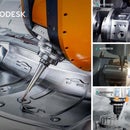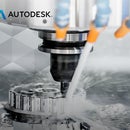Introduction: Intermediate 3D Milling
In this second lesson, we will take a deeper look at programming 3D surface milling features in from a solid model in FeatureCAM. While this part may differ from previous parts, as always, we will follow our defined workflow to help us program this part.
Step 1: Import, Stock, Machining Prep
- Open
a new document, and close the stock wizard
- Milling Setup
- Inch
- Wizard
- My Configuration
With a blank milling document open, we can now import our solid model to program features from.
- Import premium_2.x_t
The Import Wizard will help us setup our part, covering our stock step, as well as some of our machining prep.
- Align the Z direction by picking two points along one of the part's vertical edges
- Align the X direction by picking two points along one of the part's horizontal edges
- Step
through the next few windows in the import wizard to define the piece of
material we will be machining this part from
- Block
- Compute stock size from the size of the part
- Block
- Place the Setup in the center of the stock
- No multi-axis positioning
Now that we have completely worked through the import wizard, we are just a few short steps away from creating features.

- Select the Basic tool crib
- Select the Matsuura.cnc post-processor
With our part imported, stock setup, and machining details accounted for, we are ready to start programming!
Attachments
Step 2: Create Features
Now that we have setup or model for machining, let's quickly create some new toolpath to machine the model. In this exercise we will continue to experiment with the Z-Level roughing strategy, as well as a new finishing strategy - Steep and Shallow.
- Select
the model surfaces by box selecting the entire model
- Create a Z-Level Roughing operation
- Choose a single operation
- Z-Level Rough
- Leave all defaults
- Create
a Steep and Shallow Specialized Finishing operation
- Choose a single operation
- Steep and Shallow
- Leave all defaults
Step 3: Simulate, Revise
- Run a Centerline Simulation
- Run a 3D Simulation

It looks like we were able to generate successful toolpath with minimal changes! Let's dig a little deeper into our features though to explore some of our customization options.
- Adjust
the Z-Level Rough's stepdown to 0.25", and run a 3D Simulation of just that
feature
- Srf_mill1 Properties
- Rough
- Milling
- Z-increment = 0.25"
- Uncheck srf_mill2
- Run a 3D simulation

By decreasing our stepdown, we were able to improve our results from our roughing operation. That being said, check the machining time for this operation. It should be around 1:11:00. Now try using FeatureCAM's remachining options to keep the same results in less time.
- Restore
the original stepdown used for the operation, and add a step up, step cutting
value of 0.25"
- srf_mill1
- Unset Z-Increment
- Z-Level
- Remachining...
- Step cutting
- Step up = 0.25"
- Run a 3D Simulation
Now notice that we were able to seem the same result with this roughing operation in only 45 minutes! Step cutting is a very powerful option found in Z-Level Roughing operations.
Now let's inspect the results of both of our surface milling operations.
- Run
a Part Compare of our results
- In the Part View, right-click the solid
- Select 'Use Solid as Part Compare Solid'
- Run a 3D Simulation
- Select Part Compare in the sSimulation's Show drop-down menu

Notice how most of the part is highlighted green, with the exception of a few corners. As you can see, Part Compare compares our simulation results to our model, to help us check how close our toolpath is. Anything blue is excess material while anything red is material we should not have removed. To clean this part up, let's create a Corner Remachining operation
- Select
the entire model and create a Corner Remachining operation
- Surface Milling
- Choose a single operation
- Add the model surfaces
- Corner Remachining
- Multi pencil
- Remachining...
- Previous Tool Diamter: 0.5"
- Preview the new feature, and notice that toolpath is only generated in the areas with material left by the 0.5" ball end mill.
- Now run a final 3D Simulation, and run Part Compare

Now our that our toolpath matches our solid model, we are ready to save NC Code!
Step 4: NC Code
With our final simulation run, our NC Code has been generated and is ready to be sent to the machine.
- Select
the Show NC icon
 to open our NC code in the Results window.
to open our NC code in the Results window. - Select
the Save NC
 icon to save the displayed code.
icon to save the displayed code. - Save the NC code to your desired directory.
Note: This exercise is for educational purposes. The post-processor used in this exercise is a generic post-processor used for training that will likely not work for your machine. Do not attempt to run any code generated in this exercise.














